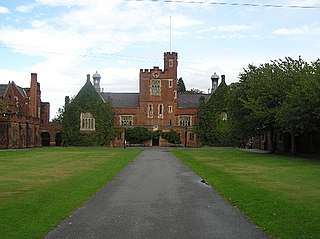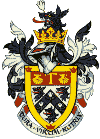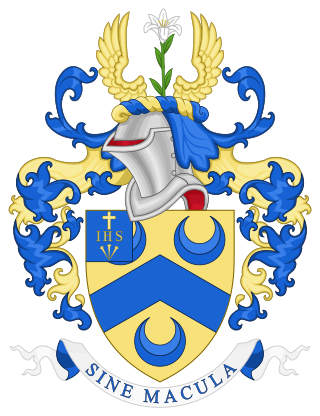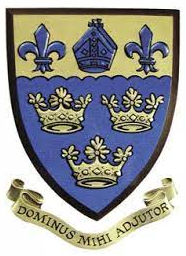
Chigwell School is a co-educational independent boarding and day school. It is a private school, and not a Public School, which is a common misconception. It is located in Chigwell, in the Epping Forest district of Essex. It consists of a pre-prep, Junior School, Senior School and sixth form. A pre-preparatory department for children aged 4–8 was constructed starting for the 2013–14 academic year.

Tonbridge School is a public school in Tonbridge, Kent, England, founded in 1553 by Sir Andrew Judde. It is a member of the Eton Group and has close links with the Worshipful Company of Skinners, one of the oldest London livery companies.

The Royal Grammar School Worcester is an eleven-eighteen mixed, private day school and sixth form in Worcester, Worcestershire, England. Founded before 1291, it is one of the oldest British independent day schools.

Loughborough Grammar School is a 10–18 independent boys school in the town of Loughborough, Leicestershire, England, founded in 1495 by Thomas Burton. Today, roughly one in ten boys at the school are boarders, with the remainder being day students. It is one of four schools known as the Loughborough Schools Foundation, along with Loughborough High School, Fairfield Preparatory School and Loughborough Amherst School.

The Duke of York's Royal Military School, more commonly known as the Duke of York's, is a co-educational academy with military traditions in Guston, Kent. Since becoming an academy in 2010, the school is now sponsored by the Ministry of Defence, and accepts applications from any student wishing to board. Before 2010, only those students whose parents were serving or had served in the armed forces were eligible.

St Lawrence College is a co-educational independent school situated in Ramsgate, Kent and has been established as a "public school" ever since it was founded.

Sedbergh School is a public school in the town of Sedbergh in Cumbria, North West England. It comprises a junior school for pupils aged 4 to 13 and the main school for 13 to 18 year olds. It was established in 1525.

Mount St Mary's College is an independent, co-educational, day and boarding school situated at Spinkhill, Derbyshire, England. It was founded in 1842 by the Society of Jesus, and has buildings designed by notable architects such as Joseph Hansom, Henry Clutter and Adrian Gilbert Scott. The school is a member of the Headmasters' and Headmistresses' Conference and the Catholic Independent Schools Conference.

Bloxham School, also called All Saints' School, is a private co-educational day and boarding school of the British public school tradition, located in the village of Bloxham, three miles (5 km) from the town of Banbury in Oxfordshire, England. The present school was founded in 1860 by Philip Reginald Egerton and has since become a member of the Woodard Corporation. The current headmaster is Paul Sanderson, who took over from Mark Allbrook in 2013. The school has approximately 515 pupils.

Ashville College is a co-educational independent school for both day and boarding pupils aged 2–18 in Harrogate, North Yorkshire, England.

Northampton School for Boys (NSB) is an 11–18 boys secondary school in Northampton, England. It was founded as Northampton Town and County Grammar School in 1541 by Thomas Chipsey, Mayor of Northampton. Years 7 to 11 are boys-only, while Sixth Form classes are mixed. The school generally ranks among the best-performing in the county.

Dean Close School is a Public school for pupils aged 3–18) in Cheltenham, Gloucestershire, South West England, UK. The school is divided into pre-prep, preparatory and senior schools located on separate but adjacent sites outside Cheltenham town centre, occupying the largest single private area of land within the town, at some 50 acres.

Borden Grammar School is a grammar school with academy status in Sittingbourne, Kent, England, which educates boys aged 11–18. A small number of girls have also been admitted to the Sixth Form. The school holds specialist status in sports.
Beaumont College was between 1861 and 1967 a public school in Old Windsor in Berkshire. Founded and run by the Society of Jesus, it offered a Roman Catholic public school education in rural surroundings, while lying, like the neighbouring Eton College, within easy reach of London. It was therefore for many professional Catholics with school-age children a choice preferable to Stonyhurst College, the longer-standing Jesuit public school in North Lancashire. After the college's closure in 1967 the property was used in turn as a training centre, a conference centre and an hôtel; St John's Beaumont, the college's preparatory school for boys aged 3–13, continues, functioning in part as a feeder school for Stonyhurst.

The Priory of St. Mary the Virgin and St. Martin of the New Work, or Newark, commonly called Dover Priory, was a priory at Dover in southeast England. It was variously independent in rule, then occupied by canons regular of the Augustinian rule, then finally monks of the Benedictine rule as a cell of Christchurch Monastery, Canterbury.
Dover Grammar School for Boys (DGSB) is a selective secondary school located in Dover, United Kingdom, whose origins can be traced back to the Education Act 1902 (the 'Balfour Act'). Originally founded as the Dover County School for Boys and Girls with locations behind the Dover Town Hall and on Priory Hill, the co-educational arrangements were early on prohibited by the Kent Education Committee. Dover Grammar School for Boys now occupies a prominent position overlooking the town of Dover on Astor Avenue. Its sister school is located in Frith Road and known as the Dover Grammar School for Girls (DGSG).

Heath Mount School is a Church of England co-educational independent prep school near Watton-at-Stone, Hertfordshire, England. It admits pupils aged 3 to 13. It was founded as Heath Mount Academy in Hampstead in 1796. In 1934 it was relocated to a Georgian mansion on the Woodhall Estate in rural Hertfordshire. For the 2022 academic year, 498 students were enrolled: boarding pupils and day pupils and girls and boys.
Stubbington House School was founded in 1841 as a boys' preparatory school, originally located in the Hampshire village of Stubbington, around 1 mile (1.6 km) from the Solent. Stubbington House School was known by the sobriquet "the cradle of the Navy". The school was relocated to Ascot in 1962, merging with Earleywood School, and it closed in 1997.

The City of Leicester College (TCOLC) is a coeducational secondary school and sixth form located in Evington, Leicester, England. It has around 2,000 pupils and specialises in business and enterprise.

Douai School was a public school run by the Douai Abbey Benedictine community at Woolhampton, England, until it closed in 1999.


















